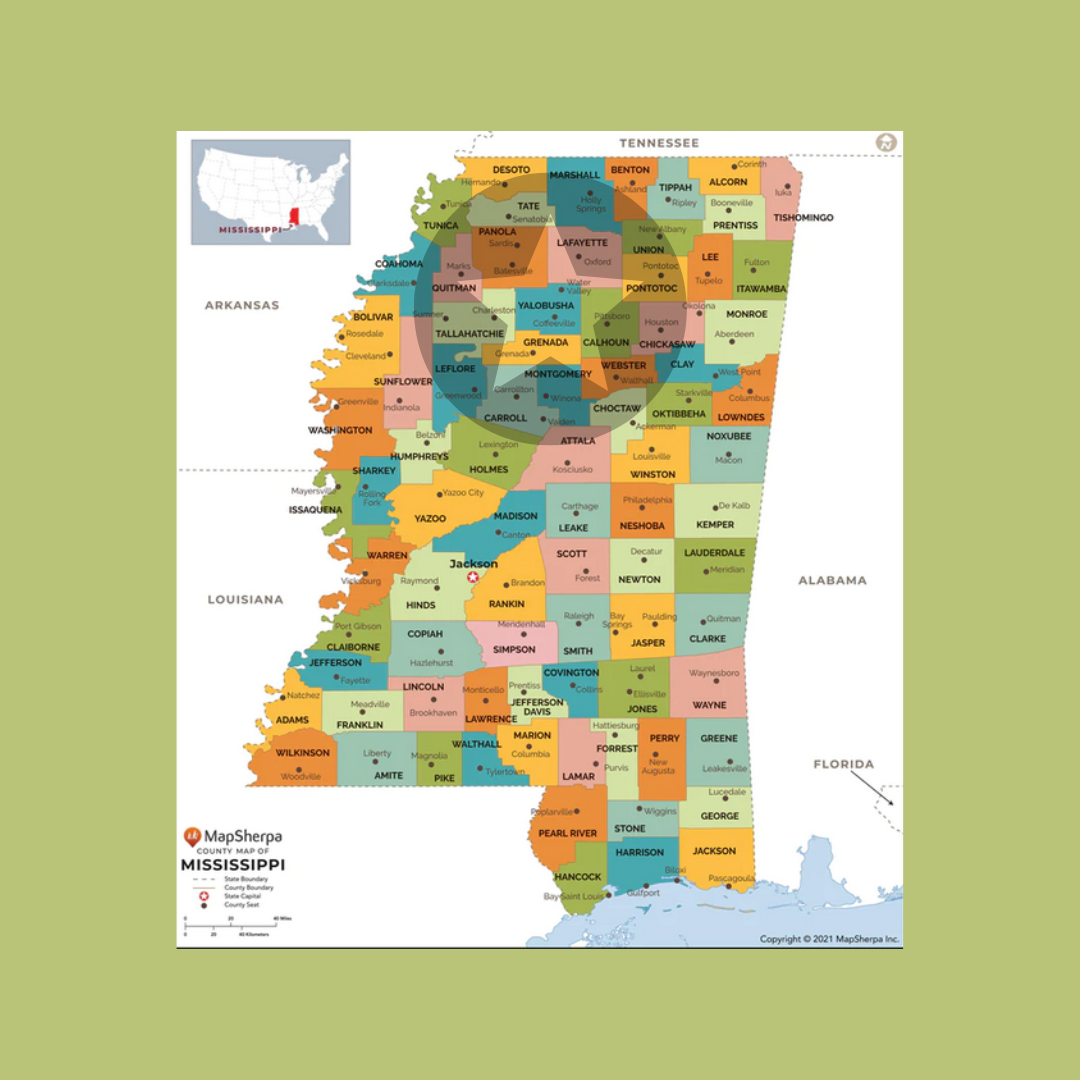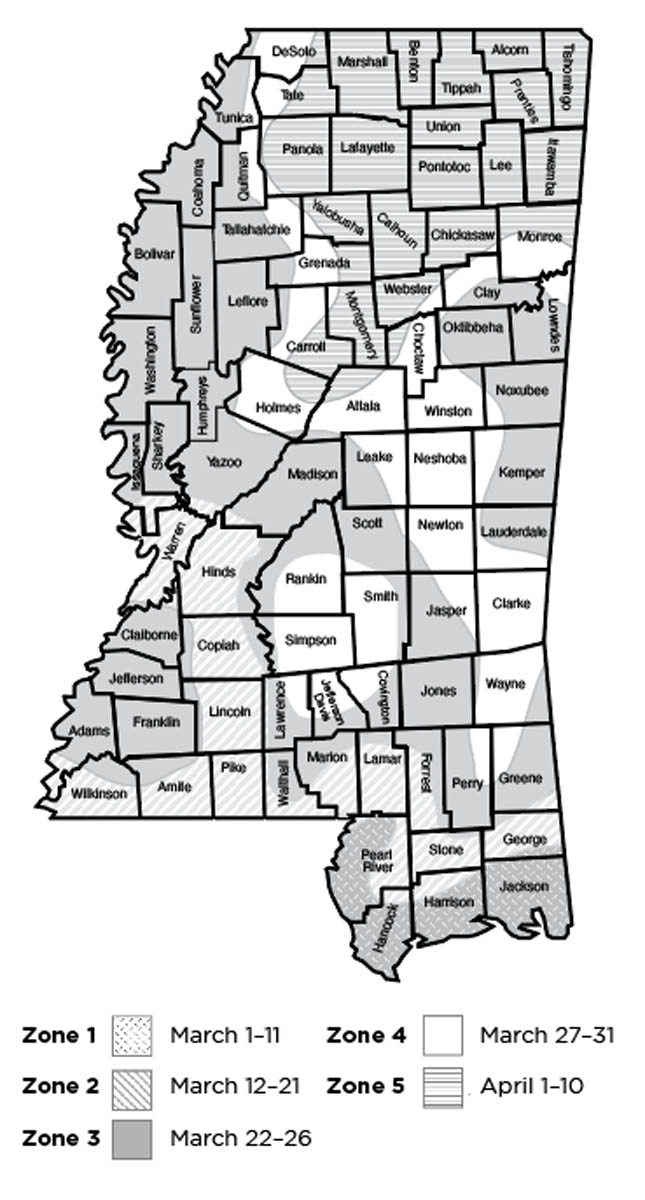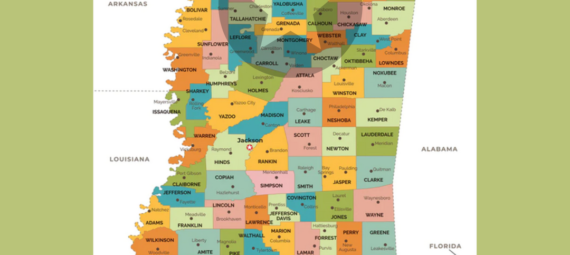
Mississippi is one of the southernmost states in the USA, but Yalobusha County is in the top quarter of the state. And while some parts of the state are quite tropical [Zone 9a], Yalobusha County is not that warm, and nationally speaking, it is in Garden Zone 7b.
The Mississippi State Extension Service has provided the following map which shows the sub-zones within the state.
\
Image Credit – Mississippi State University Extension Service
Spring and summer planting dates.
Cool-Season Vegetables
| Vegetable | Zone 1 | Zone 2 | Zone 3 | Zone 4 | Zone 5 |
|---|---|---|---|---|---|
| beets | Feb. 1 | Feb. 12 | Feb. 22 | Feb. 27 | Mar. 3 |
| Mar. 1 | Mar. 15 | Apr. 1 | Apr. 1 | Apr. 5 | |
| broccoli (plants) | Feb.1 | Feb. 13 | Feb. 22 | Feb. 27 | Mar. 3 |
| Feb. 15 | Mar. 1 | Mar. 10 | Mar. 15 | Mar. 20 | |
| cabbage, collards (plants) | Feb. 1 | Feb. 12 | Feb. 22 | Feb. 27 | Mar. 3 |
| Feb. 15 | Mar. 1 | Mar. 15 | Mar. 20 | Apr. 1 | |
| carrots | Jan. 20 | Jan. 29 | Feb. 8 | Feb. 13 | Feb. 18 |
| Apr. 15 | Apr. 15 | Apr. 15 | Apr. 15 | Apr. 15 | |
| cauliflower (plants) | Feb. 1 | Feb. 12 | Feb. 22 | Feb. 27 | Mar. 3 |
| Feb. 15 | Mar. 1 | Mar. 10 | Mar. 15 | Mar. 20 | |
| chard, Swiss | Feb. 1 | Feb. 12 | Feb. 22 | Feb. 27 | Mar. 3 |
| Mar. 1 | Mar. 15 | Apr. 1 | Apr. 1 | Apr. 5 | |
| kohlrabi | Jan. 20 | Jan. 29 | Feb. 8 | Feb. 13 | Feb. 18 |
| Mar. 1 | Mar. 15 | Apr. 1 | Apr. 1 | Apr. 5 | |
| lettuce, head | Jan. 20 | Jan. 29 | Feb. 8 | Feb. 13 | Feb. 18 |
| Mar. 1 | Mar. 1 | Mar. 1 | Mar. 5 | Mar. 10 | |
| lettuce, leaf | Jan. 20 | Jan. 29 | Feb. 8 | Feb. 13 | Feb. 18 |
| Apr. 1 | Apr. 1 | Apr. 1 | Apr. 10 | Apr. 15 | |
| mustard | Feb. 1 | Feb. 12 | Feb. 22 | Feb. 27 | Mar. 3 |
| Apr. 1 | Apr. 1 | Apr. 15 | Apr. 15 | Apr. 20 | |
| onions (sets or plants) | Jan. 20 | Jan. 29 | Feb. 8 | Feb. 13 | Feb. 18 |
| Mar. 1 | Mar. 1 | Mar. 1 | Mar. 1 | Mar. 15 | |
| peas, English | Jan. 20 | Jan. 29 | Feb. 8 | Feb. 13 | Feb. 18 |
| Mar. 10 | Mar. 10 | Mar. 15 | Mar. 20 | Apr. 1 | |
| potatoes, Irish | Jan. 20 | Jan. 29 | Feb. 8 | Feb. 13 | Feb. 18 |
| Feb. 15 | Mar. 1 | Mar. 1 | Mar. 10 | Mar. 15 | |
| radishes | Feb. 1 | Feb. 12 | Feb.22 | Feb.27 | Mar. 3 |
| Mar. 15 | Mar. 15 | Apr. 1 | Apr. 15 | Apr.25 | |
| spinach | Jan. 20 | Jan. 29 | Feb. 8 | Feb.13 | Feb.18 |
| Feb. 15 | Mar. 1 | Mar. 15 | Mar. 15 | Mar. 15 | |
| turnips | Feb. 1 | Feb. 12 | Feb. 22 | Feb. 27 | Mar. 3 |
| Apr. 1 | Apr. 1 | Apr. 15 | Apr. 15 | Apr. 20 |
Warm-Season Vegetables
| Vegetable | Zone 1 | Zone 2 | Zone 3 | Zone 4 | Zone 5 |
|---|---|---|---|---|---|
| beans, snap bush | Mar. 15 | Mar. 25 | Apr. 4 | Apr. 8 | Apr. 14 |
| Apr. 15 | Apr. 20 | May 1 | May 1 | May 10 | |
| beans, snap pole | Mar. 15 | Mar. 25 | Apr. 4 | Apr. 9 | Apr. 14 |
| Sept. 1 | Aug. 15 | Aug. 15 | Aug. 10 | Aug. 1 | |
| beans, lima bush | Mar. 29 | Apr. 8 | Apr. 18 | Apr. 23 | Apr. 28 |
| Aug. 15 | Aug. 1 | Aug. 1 | July 25 | July 15 | |
| beans, lima pole | Mar. 29 | Apr. 8 | Apr. 18 | Apr. 23 | Apr. 28 |
| Aug. 5 | Jul. 20 | Jul. 20 | Jul. 15 | Jul. 5 | |
| corn | Mar. 1 | Mar. 11 | Mar. 21 | Mar. 26 | Mar. 31 |
| Jul. 15 | Jul. 15 | Jul. 15 | Jul. 15 | Jul. 15 | |
| cucumbers | Mar. 29 | Apr. 8 | Apr. 18 | Apr. 23 | Apr. 28 |
| Sept. 14 | Aug. 28 | Aug. 21 | Aug. 14 | Aug. 10 | |
| eggplant (plants) | Mar. 29 | Apr. 8 | Apr. 18 | Apr. 23 | Apr. 28 |
| Aug. 15 | Aug. 10 | Aug. 10 | Aug. 1 | July 15 | |
| muskmelons | Mar. 29 | Apr. 8 | Apr. 18 | May 15 | Jun. 1 |
| May 1 | May 1 | May 15 | Apr. 23 | Apr. 28 | |
| okra | Mar. 29 | Apr. 8 | Apr. 18 | Apr. 23 | Apr. 28 |
| Jul. 15 | Jul. 15 | Jul. 15 | Jul. 15 | Jul. 15 | |
| peanuts | Mar. 15 | Mar. 25 | Apr. 4 | Apr. 9 | Apr. 14 |
| May 1 | May 1 | May 1 | May 15 | May 15 | |
| peas, southern | Mar. 29 | Apr. 8 | Apr. 18 | Apr. 23 | Apr. 28 |
| Aug. 10 | Aug. 10 | Aug. 1 | Aug. 1 | Jul. 20 | |
| peppers (plants) | Mar. 29 | Apr. 8 | Apr. 18 | Apr. 23 | Apr. 28 |
| Aug. 15 | Aug. 10 | Aug. 10 | Aug. 1 | Jul. 15 | |
| potatoes, sweet (plants) | Mar. 29 | Apr. 8 | Apr. 18 | Apr. 23 | Apr. 28 |
| Jul. 1 | Jul. 1 | Jul. 1 | Jul. 1 | Jul. 1 | |
| pumpkins, winter squash | Mar. 29 | Apr. 8 | Apr. 18 | Apr. 23 | Apr. 28 |
| Jul. 1 | Jul. 1 | Jul. 1 | Jul. 1 | Jul. 1 | |
| spinach, New Zealand | Mar. 15 | Mar. 25 | Apr. 4 | Apr. 9 | Apr. 14 |
| Apr. 15 | Apr. 15 | Apr. 20 | May 15 | May 15 | |
| squash, summer | Mar. 29 | Apr. 8 | Apr. 18 | Apr. 23 | Apr. 28 |
| Sept. 14 | Aug. 28 | Aug. 21 | Aug. 14 | Aug. 10 | |
| tomatoes (plants) | Mar. 29 | Apr. 8 | Apr. 18 | Apr. 23 | Apr. 28 |
| Aug. 15 | Aug. 10 | Aug. 10 | Aug. 1 | Jul. 20 | |
| watermelons | Mar. 29 | Apr. 8 | Apr. 18 | Apr. 23 | Apr. 28 |
| May 1 | May 1 | May 15 | May 15 | Jun. 1 |
Chart Provided by Mississippi University Extension Service
Okay to Plant in July:
July 1 – Pumpkins, Winter Squash
July 5 – Lima Beans Pole
July 15 – Lima Beans Bush
July 15 – Okra
July 15 – Pepper Plants
July 20 – Summer Peas
July 20 – Tomato Plants
Okay to Plant in August:
August 1 – Green Beans Pole
August 10 – Summer Squash
Succession Planting
“Many people who grow gardens only plant once during the spring. But in Mississippi, we have the opportunity to grow and harvest produce almost year-round. The long growing season combined with successive plantings (growing more than one vegetable in the same space during the year) optimizes what the garden can produce.
As soon as one vegetable is harvested, space can be cleared, prepped, and planted with another. For example, follow an early-spring planting of English peas with a late-spring planting of cucumbers; then replant the space with fall bush snap beans, leafy greens, or late southern peas. Another example is to follow early sweet corn with winter squash and pumpkins in early July. Spring Irish potatoes can be followed by lima beans or southern peas, which are followed by fall greens.
Practice crop rotation (planting nonrelated plants in the same location in successive plantings) to prevent disease buildup in the garden soil. Rotation should be by family groups. For example, don’t replace tomatoes with peppers since they are in the same family.
When growing vegetables (like snap beans, sweet corn, lettuce, radishes, leafy greens, and southern peas) that are intended to be consumed fresh from the plant, make small successive plantings of vegetables.
Planting at 2-week intervals provides continuous fresh vegetables. Plant only as much as your family can eat before the next planting begins to produce. If you plan to can and freeze as well as use fresh vegetables, plant more vegetables at one time to provide enough at harvest for preserving.
Table 3 (page 16) lists expected yields for the different vegetables. Keep in mind that the estimated yields given for some vegetables (tomatoes, peppers, okra, pole beans, and eggplant, for example) are for multiple harvests over a period. Vegetables with extended harvest periods require only one planting during the season. However, with tomatoes, peppers, and eggplant, a second planting made in midsummer provides good-quality vegetables for a fall harvest.
A second planting of okra, about 6 weeks after the first planting, has some benefit for late-season harvest, but you can get the same benefit by cutting the first planting back to a height of 3 to 4 feet in late summer.
Plant your garden according to a detailed plan. A finished garden plan shows the following:
- vegetable varieties
- number of successive plantings for each vegetable
(if applicable) - planting dates and locations
- row spacing
Related Vegetable Groups
Tomato, Eggplant, Irish potato, Pepper
Cucumber, Squash, Pumpkin, Muskmelon, Watermelon
Snap bean, Lima bean, Peanut, Southern pea
Cabbage, Broccoli, Turnip, Mustard, Collard
“Mississippi Vegetable Gardener’s Guide.” Mississippi State University Extension Service, extension.msstate.edu/publications/mississippi-vegetable-gardeners-guide.

